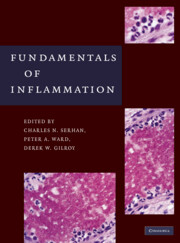Book contents
- Frontmatter
- Contents
- Contributors
- Preface
- PART I THE INFLAMMATORY RESPONSE – AN OVERVIEW
- PART II INDIVIDUAL CELL TYPES
- PART III CHEMICAL MEDIATORS
- PART IV IMMUNOPHARMACOLOGY
- PART V INFLAMMATORY DISEASES/HISTOLOGY
- PART VI ANIMAL MODELS OF INFLAMMATION
- 27 Models of Acute Inflammation – Air-Pouch, Peritonitis, and Ischemia-Reperfusion
- 28A Experimental Models of Glomerulonephritis
- 28B Glomerulonephritis and Ischemia Reperfusion Injury
- 29 Asthma
- 30 Animal Models of Rheumatoid Arthritis
- 31 Ocular Inflammation Models
- 32 Atherosclerosis in Experimental Animal Models
- 33 Oral Inflammation and Periodontitis
- 34 Pathogens and Inflammation
- Index
- References
32 - Atherosclerosis in Experimental Animal Models
from PART VI - ANIMAL MODELS OF INFLAMMATION
Published online by Cambridge University Press: 05 April 2014
- Frontmatter
- Contents
- Contributors
- Preface
- PART I THE INFLAMMATORY RESPONSE – AN OVERVIEW
- PART II INDIVIDUAL CELL TYPES
- PART III CHEMICAL MEDIATORS
- PART IV IMMUNOPHARMACOLOGY
- PART V INFLAMMATORY DISEASES/HISTOLOGY
- PART VI ANIMAL MODELS OF INFLAMMATION
- 27 Models of Acute Inflammation – Air-Pouch, Peritonitis, and Ischemia-Reperfusion
- 28A Experimental Models of Glomerulonephritis
- 28B Glomerulonephritis and Ischemia Reperfusion Injury
- 29 Asthma
- 30 Animal Models of Rheumatoid Arthritis
- 31 Ocular Inflammation Models
- 32 Atherosclerosis in Experimental Animal Models
- 33 Oral Inflammation and Periodontitis
- 34 Pathogens and Inflammation
- Index
- References
Summary
The term atheroma, derived from Greek and meaning “porridge,” was first proposed by Albrecht von Haller in 1755 to label the degenerative process observed in the intima of arteries. London surgeon Joseph Hodgson (1788–1869) published in 1815 his Treatise on the Diseases of Arteries and Veins in which he claimed that inflammation was the underlying cause of atheromatous arteries. Atherosclerosis is now widely appreciated as an inflammatory disease involving the vascular wall. Histologically, the lipid-laden foam cells of the fatty streak, which characterize the plaque at an early stage, are derived from macrophages. In time, the lipid/necrotic core is covered with fibrous tissue composed mainly of α-actin positive smooth muscle cells, and thus forms the fibrolipid plaque. Large amounts of T lymphocytes are found surrounding the plaque and in the fibrous cap, pointing to a role for the body's immune system in atherosclerosis.
Advanced complex atheromata that set the stage for overt clinical events in atherosclerosis are preceded by less complex lesions. The factors that enable some lesions to progress while others regress remain unclear. It is clear, however, that lack of regression is associated with persistent inflammation in the vascular wall. Most studies to date rely heavily on animal models to define mechanistic pathways [1, 2].
- Type
- Chapter
- Information
- Fundamentals of Inflammation , pp. 427 - 432Publisher: Cambridge University PressPrint publication year: 2010



